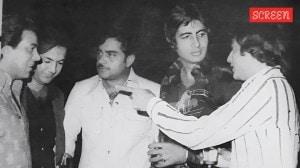While other Gandhian places have become museums, Rashtriya Shala continues to bustle with activity
Rashtriya Shala caught national attention when Mahatma Gandhi began his unplanned fast-unto-death on March 3, 1939, in protest against Dharmendrasinh reneging on his promise to Praja Pratinidhi Sabha.
 At Rashtriya Shala in Rajkot. (Express Photo)
At Rashtriya Shala in Rajkot. (Express Photo)
Painted maroon and shaded by huge trees, the historic main building of Rashtriya Shala, where Mahatma Gandhi observed a five-day-long fast during his Rajkot Satyagraha in 1939, catches the eyes of anyone travelling along Rashtriya Shala Road in the heart of the city.
The expanse of the 12-acre campus in an otherwise-crowded locality, as well as the multitude of activities related to education, rural employment and cottage industries underway on the premises is a symbol of the space that the Gandhian way of resistance against the British rule occupied in society then and the resilience of that spirit. According to a booklet published by Rashtriya Shala Trust (RST), which owns and manages the Rashtriya Shala campus, Gandhi gave a call for boycott of colonial education during the non-cooperation movement launched in 1920.
In its place, Gandhi advocated for an education that could train the youth for national rejuvenation and reconstruction as well as the fight for freedom. To that end, he founded Gujarat Vidyapith in Ahmedabad and four other universities in the country. Later on, schools were opened elsewhere in the same spirit. Rashtriya Shala (literally, national school) was one of them.
Rashtriya Shala started on February 2, 1921, as Kumar Mandir, a primary school to impart education to children in Gujarati. Chhotalal Lakshmishankar Mankad served as its first principal, while freedom fighters Jethalal Joshi, Jamnadas Gandhi and Vajubhai Shukla were among the teachers.
A committee headed by Revashankar Zaveri, with the likes of Jamnadas Gandhi and Mansukh Mehta as its members, was in charge. The who’s who of Rajkot enrolled their children in this school.
Sir Lakhajiraj Jadeja, the then ruler of princely state of Rajkot, leased 13 acres of land to Rashtriya Shala at a token rent in April 1924. With the help of donors, the committee got various buildings constructed on the campus and the school shifted to its permanent campus.
Later on, Nanalala Jasani became the president of Rashtriya Shala and Narandas Gandhi, son of Mahatma Gandhi’s cousin Khushalchand Gandhi, became its manager. Narandas was the secretary of the Sabarmati Ashram in Ahmedabad.
But Mahatma Gandhi, while embarking on his historic Dandi March in 1930, left the Sabarmati Ashram and took a vow to not return without winning India its freedom. As per the booklet from Rashtriya Shala, on the instructions of Mahatma Gandhi, Nanrandas shifted to Rajkot to manage the school’s affairs. Rashtriya Shala decided to purchase the land on which the campus had been developed, and Dharmendrasinh Jadeja, who succeeded Sir Lakhajiraj on the throne of Rajkot state after the former’s death in 1930, agreed.
The deal was sealed on April 6, 1935. Gandhi, who had spent his formative years in Rajkot when his father Karamchand Gandhi was Rajkot’s prime minister, himself drafted the Constitution of Rashtriya Shala. Under Narandas’s leadership, Rashtriya Shala expanded its activities in the field of spinning and weaving, women empowerment, drought relief, nursery education etc. Accordingly, Balmandir, a nursery section was added to the school in 1935.
The same year, a music school was started. To promote self-reliance, Rashtriya Shala started spinning and weaving activities, establishing Khadi Mandir for production and sale. An oil mill was also set up the same year.
Rajkot Satyagraha
However, Rashtriya Shala caught national attention when Mahatma Gandhi began his unplanned fast-unto-death on March 3, 1939, in protest against Dharmendrasinh reneging on his promise to Praja Pratinidhi Sabha. A representative assembly established by Dharmendrasinh’s late father Sir Lakhajiraj in 1923, the Praja Pratinidhi Sabha had powers to make recommendations to the state.
The convention was that the ruler rarely used to exercise his veto against such recommendations. In his book Saurashtrama Gandhiji, freedom fighter and author Kantilal Shah writes that to support his lavish lifestyle, Dharmendrasinh started giving away monopolies of match sticks, sugar, ice, etc.
That led to a price rise, prompting the Praja Pratinidhi Sabha to protest. Freedom fighters such as Uchchhrangrai Dhebar and Shukla staged public protests and defied the writ of the Rajkot state, marking the beginning of the Rajkot Satyagraha. The state attempted to crush the protests by using force and arresting leaders such as Dhebar and Shukla.
To support the popular fight for people’s rights, Sardar Vallabhbhai Patel came to Rajkot and addressed a public meeting. Later, he sent his daughter Maniben to Rajkot. But the state arrested her too. However, the strong-arm tactics by the state only intensified the protests. Shah writes in his book that this forced Dharmendrasinhji to seek a compromise and indirectly seek the intervention of Patel and Mahatma Gandhi. Patel came to Rajkot and after negotiations, he agreed and signed a draft agreement, promising to delegate more powers to the people. He agreed to the formation of a 10-member committee, comprising seven members recommended by Patel and three by the state. The committee was to make its recommendations within a month.
However, Shah writes in his book, under pressure from the officers of the British regime and advice from his prime minister Viravala, Dharmendrasinh rejected three of the names suggested by Patel. This led to further intensification of protests. Leaders such as Bechar Jasani, Shukla and Joshi went on a hunger strike. Hearing about atrocities that the people of Rajkot had faced, Kasturba Gandhi, the wife of Mahatma Gandhi, came to Rajkot to join the satyagraha. But she too was jailed.
Mahatma Gandhi corresponded with the Rajkot state but the latter denied any atrocities. Gandhi came to Rajkot on February 28, 1939, put up at Rashtriya Shala and requested Dharmendrasinh to honour his promise with respect to the reforms committee. However, the ruler and his prime minister denied any breach of promise. Through a letter on March 2, Gandhi made one final request to the ruler to honour his promise, informing him that he would start a hunger strike if his requests were not granted by 3 pm the next day. As he did not receive Dharmendrasinh’s response, Gandhi started his hunger strike in his room in Rashtriya Shala on March 3, 1939. Eventually, Gandhi ended his hunger strike on March 7, 1939, after agreeing with the suggestion of Victor Alexander.







